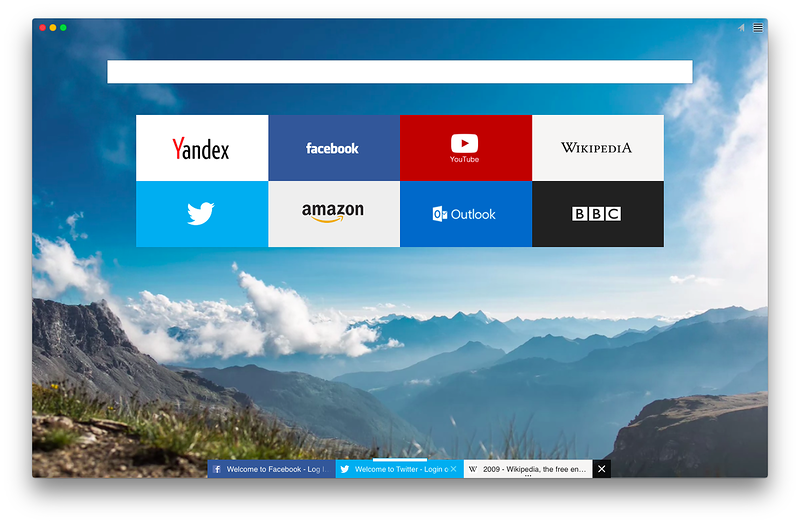The minimalist concept version of our Yandex.Browser launched at the end of last year to respond to the highly interactive nature of contemporary web browsing is now available as a beta version, which is designed to also address the rising demand for personal privacy.
To meet the expectations of those users who would like to have more control over their digital footprint, we’re now rolling out a much more private beta version of the experimental Yandex.Browser, available in 15 languages, including English, German, Portuguese, Spanish and French.

Unlike in most browsers, sending the information about users’ behaviour to the developer (i.e. Yandex) in the private version of Yandex.Browser is disabled by default. While sharing browsing history and web cache can in principle be disabled in other browsers, this opportunity isn’t normally offered as a default option. Sharing users’ information helps developers better understand their behaviour and offer them a better browsing experience. The problem is that the right to make a decision whether to share this information is effectively removed from the user – few can find a pathway to customised privacy settings in a browser.
In addition to data sharing disabled by default, Yandex.Browser provides the ‘Stealth Mode’ option, which blocks analytics cookies, sharing plugins etc. This mode is activated by clicking a button conveniently located right next to the browser’s ‘smartbox’, a combined search and address bar, at the top of the screen. The source code of the built-in blocking extension was developed by AdGuard and is available on Github for anyone to see.

Safe browsing, as well as search suggestions appearing in the browser’s smartbox, is the feature indispensible for contemporary browsing that relies on sharing user information, albeit in an anonymised form. The safe browsing technology allows us to warn the user about unsafe websites. Each fraudulent or potentially harmful website that we identify in the process of indexing more than 30 million webpages every day is logged in our proprietary cloud database. Every time a user is about to visit a website, the website’s address is automatically checked against this database to see if it might be there and whether a warning should be shown.
We have modified the safe browsing technology to use it in our privacy-conscious version of Yandex.Browser. Instead of sending the full address of a website the user is about to visit to Yandex in order to check this address against the database of potentially harmful websites, Yandex.Browser only uses a fraction of a ‘hash’ of this website, which is checked against a ‘hashed’ database of potentially harmful websites on the user’s own computer. The browser uploads a ‘shell’ of this database to the user’s computer at the first launch. This database is then ready to be ‘filled’ with fractions of ‘hashed’ website addresses the user intends to visit. To keep this database updated and the user safe, Yandex.Browser synchs the database on the user’s computer with Yandex’s cloud database every hour, using only fractions of each hash.
Search suggestions in the browser’s smartbox give instant answers to users’ search queries without redirecting them to search results pages. The users of Yandex.Browser can at the first launch choose a default search provider from a selection of three, which varies depending on the user’s location.

To generate search suggestions, predict search terms and offer instant results without redirecting the user to the search results page, the browser has to share the search terms with the search provider as the user enters them into the browser’s smartbox. This option is enabled by default in Yandex.Browser. Although this type of data sharing can be disabled in settings, its benefits massively outweigh privacy risks. Also, web users have an opportunity to add any search provider they trust to the browser and set it as the default.
One of the flagship features of the new Yandex.Browser is rich search suggestions, which instantly take the user directly to the website, or even specific page on a specific website, via a widget and bypassing the search results page. Similarly, simple, straightforward searches in the smartbox of the new Yandex.Browser will retrieve simple and straightforward results right in the browser.

Other automated features essential for the contemporary web surfing, such as sending crash reports, resolving web navigation errors, or the autofill function, involve sharing users’ information in one form or another. These features remain enabled by default. The user has full control over this aspect of their browsing experience and can disable any or all of these features.
The beta version of experimental Yandex.Browser retains its minimalist look to offer the user unhindered experience interacting with the website. Browser tabs can now be toggled within groups, while tab groups can be moved within windows. Website information, the smartbox and favourite websites are hidden when not in use and can be summoned by clicking on the website’s header in Yandex.Browser.
Just like the alpha version of experimental Yandex.Browser, the beta version is available for Windows and OS X and can be downloaded at browser.yandex.com.